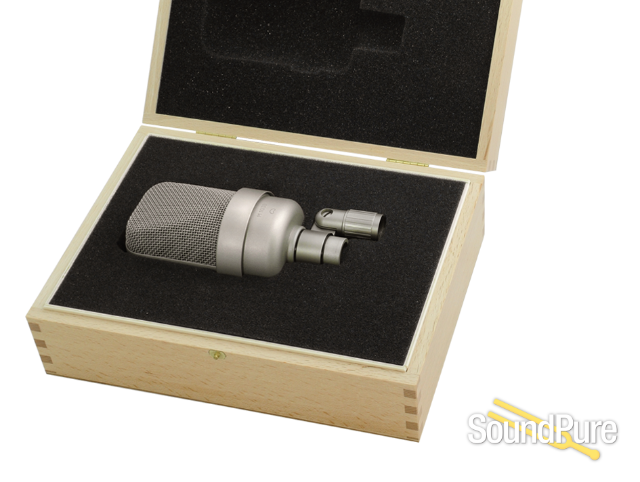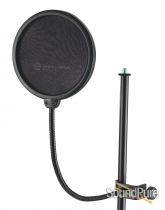-
Call Us Toll Free888-528-9703
-
Local/International (+1)919-682-5552
- Call Us! Toll Free! 888-528-9703
- Local / International (+1) 919-682-5552

$2,154.00
"Experience the Difference"
 Payments as low as $49/mo.
Payments as low as $49/mo.
Manufacturer's Description from Gefell
The studio condenser microphone M 1030 combines modern large diaphragm capsule technology with the latest in semiconductor circuit topology. The size of the microphone housing is optimized with regard to the expectations of a large diaphragm microphone for studio applications. The microphone is specifically designed to meet the needs of professional and semiprofessional users who demand the highest performance. The microphones are ideally suited for universal miking applications in broadcast and sound studios. Applications include vocalists, announcers, dialog pickup and as spot microphones for recording guitars, keyboard, percussion, wind and string instruments.
The electronic impedance converter uses a perfected circuit topology. This design reduces the noise floor to an extremely low level while also raising the maximum output capability. As a result, these microphones have a clean, distortion free sound over anextremely wide dynamic range. RFI susceptibility is very low.
Features
♦ Extreme dynamic range
♦ Noise floor 7 dB-A
♦ Large diaphragm capsule
♦ Polar pattern
♦ Universal applications
♦ Advanced circuit design
♦ Transformerless output
♦ Internal elastic suspension
♦ Optical ready indicator

About Manufacturer
Since its founding by Georg Neumann in 1928, the company has produced high quality, condenser microphones for broadcasting and recording. Many models have used the M7 capsule originally designed by Mr. Neumann in 1949 for the CMV563a. The M7 was responsible for the legendary sound of the Berlin manufactured U47, U48 and M49 microphones. Today, under the technical supervision of Mr. Kuehnast's son, the Company still produces the M7 capsule in exactly the same way Mr. Neumann taught the elder Kuehnast in the 1940's. Hand drilling each hole in the backplate, making the PVC membrane, and even gluing it together by hand is done just as Mr. Neumann specified. The M7 is currently used in the UM 92.1S, UMT800, UMT70S and MT71S Gefell manufactured microphones.
Some of the production equipment which Microtech Gefell GmbH uses for capsule production capitalizes on advanced technology developed by the Soviets before Perestroika. One of the more recently developed microphones, the M300, uses a capsule made of ceramic material molded under high pressure and plated with chromium. This technology was developed in Moscow using advanced computer modeling and simulation techniques. Gefell perfected a capsule manufacturing process unlike any employed in making Western microphones.
The SMS70 series of microphones designed in the early 1970's used a hybrid amplifier with an fet stage. Hybrid technology was not adopted by manufacturers of Western microphones until the late 1980's. Microtech's newest amplifier for the UMT70S series microphones uses surface mount device (SMD) technology.
The company also manufactures a complete line of measurement microphones equivalent to those of Bruel & Kjaer, the Danish manufacturer. These microphones are tested to the highest standards currently used in the West. The manufacturing methods for the nickel membranes and backplate assemblies are highly advanced. Testing each microphone takes a minimum of three months to guarantee performance and stability when it leaves the factory.
Before the Reunification of Germany the company manufactured their studio and broadcast microphones for RFT, a state agency that distributed them to customers in the Eastern Bloc. Most of the microphones went into the broadcast system. Some microphones, like the PM 860, went into public address systems. Virtually every town hall and auditorium in the former Soviet Union has one. About 1985, the Company began developing high powered (30 to 100 Watt) industrial lasers. They still use a laser engraving machine to put the name and serial numbers onto microphones and other finished metal products. During this period, the East German government poured 60 Million Ost Mark into the company allowing them to buy sophisticated equipment and construct a new building.
Specifications
Polar pattern: cardioid
Acoustic operating principle: pressure gradient transducer
Frequency range: 20 Hz to 20.000 Hz
Sensitivity at 1 kHz: 21 mV/PA
Output impedance: 100 Ohm
Noise level: CCIR 468-4: 13 dB
DIN EN 60268-4: 7 dB-A
Signal-to-noise ratio: CCIR weighted: 81 dB
A-weighted: 87 dB
SPL for THD 0,5 %: 142 dB
Max. output level: R = 1 kOhm 17 dBu
R = 10 kOhm 18 dBu
Dynamic range: 135 dB
Current consumption: 3,6 mA
Output connector: XLR3M
Weight: 355 g
Length: 145 mm
Diameter: 66 mm
Surface: satin nickel












